| Pages:
1
2
3
4
..
16 |
Peyman
Oud Junkie
    
Posts: 496
Registered: 7-22-2005
Member Is Offline
Mood: Mahoor
|
|
Lookg forward to this project. I remembered that I once said I can scan the original pictures from Kanzol-tohaf with regards to the old time oud. If
you still want these, let me know. Frankly, they are not great but I guess they might be interesting.
|
|
|
jdowning
Oud Junkie
    
Posts: 3485
Registered: 8-2-2006
Location: Ontario, Canada
Member Is Offline
Mood: No Mood
|
|
Thanks Peyman. Yes, I would be interested in seeing those pictures. Can you post them on this thread?
|
|
|
Peyman
Oud Junkie
    
Posts: 496
Registered: 7-22-2005
Member Is Offline
Mood: Mahoor
|
|
Here are the scans from "Kanz al tuhaf." My book doesn't specify which drawing came from what copies. The two drawings are very different. It would be
interesting to find the originals manuscripts and study the drawings.
|
|
|
Peyman
Oud Junkie
    
Posts: 496
Registered: 7-22-2005
Member Is Offline
Mood: Mahoor
|
|
I deleted the side by side picture since it made the picture too wide. I editted it for better comparison.
|
|
|
jdowning
Oud Junkie
    
Posts: 3485
Registered: 8-2-2006
Location: Ontario, Canada
Member Is Offline
Mood: No Mood
|
|
Thanks Peyman. I had seen the top image before but not the bottom one. Is it possible to decipher the script on that image? What I find particularly
interesting is the sickle shaped pegbox with the large finial set - back at an acute angle of 90 degrees to the neck. It looks similar to the pegbox
represented in the oud engraving.Hard to say if the finial is flat and , say, heart shaped or is some kind of carving - representing a head perhaps?
|
|
|
Peyman
Oud Junkie
    
Posts: 496
Registered: 7-22-2005
Member Is Offline
Mood: Mahoor
|
|
I put down the descriptions from my book. The phrases marked with the star are from the cleaner picture (the top one) and don't appear on the bottom
one.
I also think the peghead is interesting. I remembered that the shape is reminisant of old barbats I saw on Arafati's website. I think you should take
a look at the bottom row: http://oudarafati.com/gallery3-en.htm
I don't speak German but I think the metal works are from the Sassanid era.
|
|
|
jdowning
Oud Junkie
    
Posts: 3485
Registered: 8-2-2006
Location: Ontario, Canada
Member Is Offline
Mood: No Mood
|
|
Thanks Peyman. Dr G.H. Farmer makes a few references to the Persian manuscript Kanz al tuhaf by Muhammad al-Amuli (14th C) concerning the structure of
the oud and the fretting of the oud. He mentions that he used the copy in the British Library catalogue # Or 2361, for his translation so presumably
this could be obtained on microfilm from the BL? I must check. Farmer makes no mention the of the instrument with frets previously posted and states
that he could not find any pictures of ouds with frets from this period. So presumably this drawing is not intended to be an oud but some other
instrument?
My knowledge of German learned in school is now just a distant memory but from what I can understand from reading the text describing the Persian
silverware posted on the Arafati site, the earliest article - a chased silver bowl is dated to the 6th C (so is Sassanid era) shows, among other
instruments, a 'short necked lute' played with a wooden plectrum. (Interestingly the musicians are shown performing under grape vines - but that is
another story!). The other two pieces of decorated metal ware are dated to the 8th to 10th C and show four stringed 'lutes' (described as 'barbats' in
the German text). The shape of all three ouds, having no distinct neck joints, implies that the bowls are carved from a solid piece of wood (so are
barbats?) unlike the oud in the engraving - the subject of this thread - that has a bowl made from staves. The engraving of the oud is supposed to
come from the 14th C kitab al-adware by Safi al Din but this has yet to be confirmed.
For information, Farmer gives the names of the strings of the early four course oud as Bam, Mathlath, Mathna and Zir.
|
|
|
Peyman
Oud Junkie
    
Posts: 496
Registered: 7-22-2005
Member Is Offline
Mood: Mahoor
|
|
I guess my point was that the kanzaltohaf picture is pretty close to these old time ouds (pre 600 ACE). It's interesting: one of the oud has what
looks like "s" shaped soundholes.
In Kanzoltohaf, I re-read the part about ouds and as you say there is no mention of frets so that first picture is definitely not accurate (to me it
looks like a turkish cumbus, a modern instrument). In Farabi's "Great Music", the frets are mentioned.
One other miner note is that the author of Kanzaltohaf is unknown. I am not sure where Farmer got his name.
|
|
|
jdowning
Oud Junkie
    
Posts: 3485
Registered: 8-2-2006
Location: Ontario, Canada
Member Is Offline
Mood: No Mood
|
|
To my eye the kanz al tuhaf oud (if that is where the image originates) has a sharp transition between neck and bowl (i.e. a neck joint) so is not
comparable to the Sassanid instruments represented in the metalwork artifacts. These have a smooth transition between neck and bowl implying that they
are carved from a solid piece of wood (whereas a neck joint implies that the bowl is built up from staves). The crude representations illustrate the
difficulty of being able to obtain much useful information from very early sources. To attempt to reconstruct an instrument based on these images
would be futile - pure guesswork. Nevertheless, some early images may have some potentially useful information - like the sickle shaped pegbox of the
kanz al tuhaf drawing already mentioned.
The attached images show oud(?) players depicted on Sassanid era (6th and 7th C) metal plates (interestingly, both performing under grape vines). Both
instruments have the sloping shoulders typical of instruments carved from the solid (assuming that the bowls are round and not flat backed). The image
of a European 15th C Gittern (i.e. not a lute) illustrates quite well the carved body.
However, discussion of musical instruments of the 6th C - although of general interest - is off topic. So to return to the 14th C and the oud that is
the subject of this thread.
Farmer refers to, and translated from, an original copy of the kanz al tuhaf in the British Library shelfmark Or 2361. He gives the dates of various
copies of this manuscript as 1346, 1355 and 1362. He also gives the name of the author as Muhammad al Alumi that is presumably marked on his copy of
the manuscript? He states that three 14th C writers mention the use of frets (dasatin) on ouds - Quth al-Din al-Shirazi, Ibn Ghaibi and the author of
kanz al tuhaf. He also states that he could find no evidence of frets depicted on hundreds of pictures of the oud dating from the 13th C to the 20th
C.
Peyman, can you give more details of your reference source of the kanz al tuhaf? Is it a modern facsimile of the entire manuscript or an incomplete
modern edition only providing extracts from the manuscript with pictures from other non specified sources?
I have tried to trace the manuscript Or 2361 on-line at the British Library but it is not listed among the Reference section so may only be accessible
to researchers with privileged access visiting the Library reading rooms in London.
The engraving of the oud that is the topic of this thread is supposed to be printed in one of the kitab al-adwar manuscripts written in 1333-34
although this has yet to be verified. The British Library lists two modern publications of the manuscript in their Reference section the first being a
facsimile published in 1984 by publisher Frankfurt : Ma'had Tarikh al Ulum al Arabiya wa-al-Islamiyah reproduced from the MS Nuruosmaniye 3653,
Istanbul and the second appears in "La Musique Arabe" by Baron Rudolphe von Erlanger originally published in Paris by P. Geuthner in 1930. These two
books can only be referenced by visiting the British Library Reading Rooms - they cannot be obtained on loan or electronically copied due to copyright
restrictions. So if anyone has access to these modern titles or is able to read them through a National Library it would be interesting to know if
either volumes contain the oud engraving.
"La Musique Arabe" - 6 volumes, is currently being offered for sale via Addall Books for around $300 plus shipping - unfortunately a bit too expensive
for me to purchase.
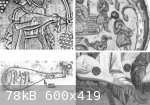
|
|
|
jdowning
Oud Junkie
    
Posts: 3485
Registered: 8-2-2006
Location: Ontario, Canada
Member Is Offline
Mood: No Mood
|
|
Checking again with AddALL books on line - the Kitab al- Adware is covered in Volume 3 of "La Musique Arabe" by Erlanger. This single volume (1938
publication) is offered for sale for $86 US by a Swiss book seller - still too expensive for me!
Also, for anyone interested, Volumes 1, 2 and 3 of the 1938 publication are on sale for $165 US from an American dealer.
|
|
|
Peyman
Oud Junkie
    
Posts: 496
Registered: 7-22-2005
Member Is Offline
Mood: Mahoor
|
|
You have sharp eyes!
The book I have is a facsimile. I assume it's from the British copy. At the begining, original pictures are printed. The author is given as Hasan
Kashani. The name is derived from one of the lines in a poem in the book itself, where the author refers to himself.
As for the frets (Dasatin), what I meant is that they are not mentioned on the oud construction segment but are covered elsewhere, in a segment of
their own. I was looking through it again and noticed that there are drawings as well. I can scan these parts. The problem is that the descriptions
written are way over my head. The drawings are labled in Arabic, which is not my forte. And the descriptions are too vague to me, especially the units
of measurement.
I am going to read the intro which has some information about Safiaddin's work as well.
Just an idea, can't you email them and ask them if these copies have the engraving? From my universtiy days, I remember that librarians are very
enthusiastic in assisting in these types of situation.
|
|
|
jdowning
Oud Junkie
    
Posts: 3485
Registered: 8-2-2006
Location: Ontario, Canada
Member Is Offline
Mood: No Mood
|
|
There is also an article about Erlanger and "La Musique Arabe" published in Al-Ahram weekly at http://weekly.ahram.org.eg/2002/577/bo5.htm
The British Library also lists "al Adwar fi al-musiqa" publisher "al Qahirah:al-Hay'ah al- Ammah lil-Kitab, 1986. 338 pages.
I shall explore the possibilities with the BL as you suggest Peyman - as well as the Canadian National Library resources - to see where it might lead.
The BL seems to be very commercially oriented these days but still worth a try. I assume that they still hold this manuscript in their collection - so
that would be a starting point for me to verify. I shall post whatever I am able to discover for information.
By all means post whatever you think might be useful - as others on the forum might be able to assist with translations etc. I cannot read
Arabic/Persian at all so am totally dependent on others in this respect.
Do you have an ISBN reference for your facsimile publication?
|
|
|
Peyman
Oud Junkie
    
Posts: 496
Registered: 7-22-2005
Member Is Offline
Mood: Mahoor
|
|
Just a thought: sometimes you can find these books listed on amazon.com. I was looking for a famous book (greek folk musical instruments) and I
noticed it was listed on amazon but it was too expensive (around 150 to 200). I kept waiting and saw listings come and go, untill last january, when I
saw it listed for $25! So I bought it right away. It's a giant book with lots of illustration, and has an "lauto" (greek lute) construction section.
You can even post the name of the book and the price you're willing to pay and some of these sellers will help you. It's worth a try.
The Kanzultohaf book I have was printed in 1992 by a famous Iranian ethnomusicologist. There is 2 other manuscripts in the book as well. I got the
book upon my friend's recommendation since I was interested in some lost instruments of the antiquity (like the original Robab and the bowed "gheshak"
and harps). This friend of mine who is a mathematician has an interest in these types of manuscripts and his father just completed a book on
Ghotboddin Shirazi (you mentioned his name before). Anyway, I am going to ask him if he knows anything about this engraving. Kitabal-adwar is a famous
book. I am sure he knows something about it.
I'll do the scanning tomorow since I won't have time today.
|
|
|
suz_i_dil
Oud Junkie
    
Posts: 1064
Registered: 1-10-2008
Member Is Offline
Mood: No Mood
|
|
Good evening.
I am taking the thread in way, and did not read the whole discussion. So excuse me if I am off topic.
The whole volumes of Rodolphe d'Erlanger are still edited and sale by l'institut du monde arabe, in Paris.
Under name " la musique arabe " coedition institut du monde arabe / Paul Geuthner.
It depends on which volume, but they are sold between 25 and 45 euros each.
http://www.imarabe.org/ ( not in the online catalog, but ask by email or telephone to their book store ), I get volume 5 and 6 by them,
something like 2 years ago.
Also available in the catalog of Avicenne Library, in Paris.
http://www.lib-avicenne.com/musique.htm
|
|
|
jdowning
Oud Junkie
    
Posts: 3485
Registered: 8-2-2006
Location: Ontario, Canada
Member Is Offline
Mood: No Mood
|
|
Thanks for the links suz_i_dil. All potentially useful information is welcome at this stage of the project.
Before picking up the thread again on construction of the oud, this might be a good time to pose two questions that sooner or later need to be
resolved. The first is how to interpret the strange pegbox terminal on the engraving. From the limited pictorial evidence so far it might be concluded
that the pegbox in the engraving represents a side view and that the 'finial' is, therefore. a flat plate of some shape. My guess is that it might be
a 'tear drop' shape that can be found on other early oud like instruments as well as - oddly enough - the Portuguese guitar.
All other data that might support (or deny!) this speculation is welcome.
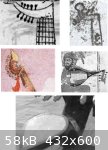
|
|
|
jdowning
Oud Junkie
    
Posts: 3485
Registered: 8-2-2006
Location: Ontario, Canada
Member Is Offline
Mood: No Mood
|
|
The second question concerns the number of sound holes. The engraving only represents two small sound holes but there is a possibility that an
additional large sound hole may not have been shown because of the difficulty of engraving the sound hole as well as the strings. Also, I have not
seen any pictures of early ouds with only two small sound holes but have to admit that I have not seen many pictures of early ouds from which to
judge.
Peyman has noted that an early post Sassanid era (9th C) representation of an oud like instrument, chased on a metal artifact, has - what seem to be -
two 'S' shaped sound holes. But are they? The 13th C Spanish 'Cantigas de Santa Maria" shows two players holding oud like instruments that have
similar shaped 'sound holes' (also with what seems to be central sound holes?). Another illumination from the same book shows an oud like instrument
with a triple rosette soundhole as well as two 'S' shaped features. Perhaps the latter are not sound holes at all but simply some kind of decorative
inlay?
My current opinion is that I should build this oud with three soundholes - one large and two small. Alternatively, I could build it first with two
small sound holes - exactly as represented in the engraving - and then remove the sound board to add a large central sound hole so that the two
configurations might be tested and compared.
Again, all data that might help resolve this question is welcome.
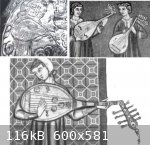
|
|
|
jdowning
Oud Junkie
    
Posts: 3485
Registered: 8-2-2006
Location: Ontario, Canada
Member Is Offline
Mood: No Mood
|
|
Moving on to the next stage in construction - the mold bulkheads have been laid out geometrically (on both sides of each bulkhead) and cut roughly
oversize on the bandsaw. Although I have used plywood for the mold baseplate I prefer to use pine for the bulkheads as it is a lot easier to work
accurately than plywood. However, as pine is subject to shrinkage on drying, the pine boards (stored in an outside building) have been left to dry in
a warm kitchen for several days before laying out the bulkheads. The metal template, for convenience, was used for the layout and the geometry then
double checked using dividers to correct any inevitable slight deviations (pine being soft, marks made through the template with a scriber point tend
to drift slightly when contacting the harder wood grain).
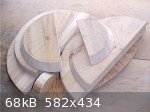
|
|
|
jdowning
Oud Junkie
    
Posts: 3485
Registered: 8-2-2006
Location: Ontario, Canada
Member Is Offline
Mood: No Mood
|
|
Now that the bulkhead geometry has been defined as accurately as possible, the rib profiles on each bulkhead are cut using a stiff backed razor saw
(Lee Valley cat# 60F03.12 - good value for around $10). The saw cuts will remain as a reference after the bulkheads are finally profiled and
shaped.

|
|
|
SamirCanada
Moderator
     
Posts: 3405
Registered: 6-4-2004
Member Is Offline
|
|
exellent! now we can see this thing shape up.
I have had less and less time to work on my project 
hopefully I will find sometime before the summer.
|
|
|
jdowning
Oud Junkie
    
Posts: 3485
Registered: 8-2-2006
Location: Ontario, Canada
Member Is Offline
Mood: No Mood
|
|
The next stage is to trim the mold bulkhead profiles down to the circumferential scribed lines. If the bulkheads were made from plywood the shaping
would best be done with a 'Surform' tool (for rough profiling) and finished with a fine wood rasp file followed by a sandpaper block. For pine
bulkheads the most efficient method is to carve away most of the waste material with a paring chisel and then finish the job with a small block plane.
Needless to say both chisel and plane need to be razor sharp to produce a clean, accurate finish.
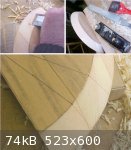
|
|
|
jdowning
Oud Junkie
    
Posts: 3485
Registered: 8-2-2006
Location: Ontario, Canada
Member Is Offline
Mood: No Mood
|
|
This year is going to be a busy one for you Samir - not much time for instrument making projects I suspect!!
I have given up on my local Museum historical commitments for this year as I need to catch up on a considerable backlog of mundane repairs/upgrades to
house and home, not to mention repairs to essential mechanical equipment car. tractors etc. as well as to, hopefully, focus a little more on
instrument building and research.
This current 'crazy' weather (an Arctic minus 30 C a week ago and now a record plus 10 C with torrential rain in the forecast for tomorrow!) gives me
an excuse to work on instruments while it lasts. Lets see how it goes.
|
|
|
jdowning
Oud Junkie
    
Posts: 3485
Registered: 8-2-2006
Location: Ontario, Canada
Member Is Offline
Mood: No Mood
|
|
To prevent chipping of the edges of the saw cuts as the bulkheads are shaped to their final dimensions, thin black card has been glued into the cuts.
These inlays will also provide a clearer definition of the rib joint locations on the completed mold.

|
|
|
jdowning
Oud Junkie
    
Posts: 3485
Registered: 8-2-2006
Location: Ontario, Canada
Member Is Offline
Mood: No Mood
|
|
It is important that each bulk head should be mounted 'square' to the baseplate of the mold. Squaring each bulk head is easily accomplished by
'shooting' the bottom of each one using a shooting board and jointer plane. A small allowance of surplus material has been left on the bottom of each
bulk head for this final trimming operation.

|
|
|
Peyman
Oud Junkie
    
Posts: 496
Registered: 7-22-2005
Member Is Offline
Mood: Mahoor
|
|
More pictures
I scanned some pictures from my book on historical instruments (the Azerbaijan musical instruments). I hope they are of some help. The picture might
be a bit too big but I can resize. I was shooting for detail of the peghead.
|
|
|
Peyman
Oud Junkie
    
Posts: 496
Registered: 7-22-2005
Member Is Offline
Mood: Mahoor
|
|
Ok, here is another try.
|
|
|
| Pages:
1
2
3
4
..
16 |